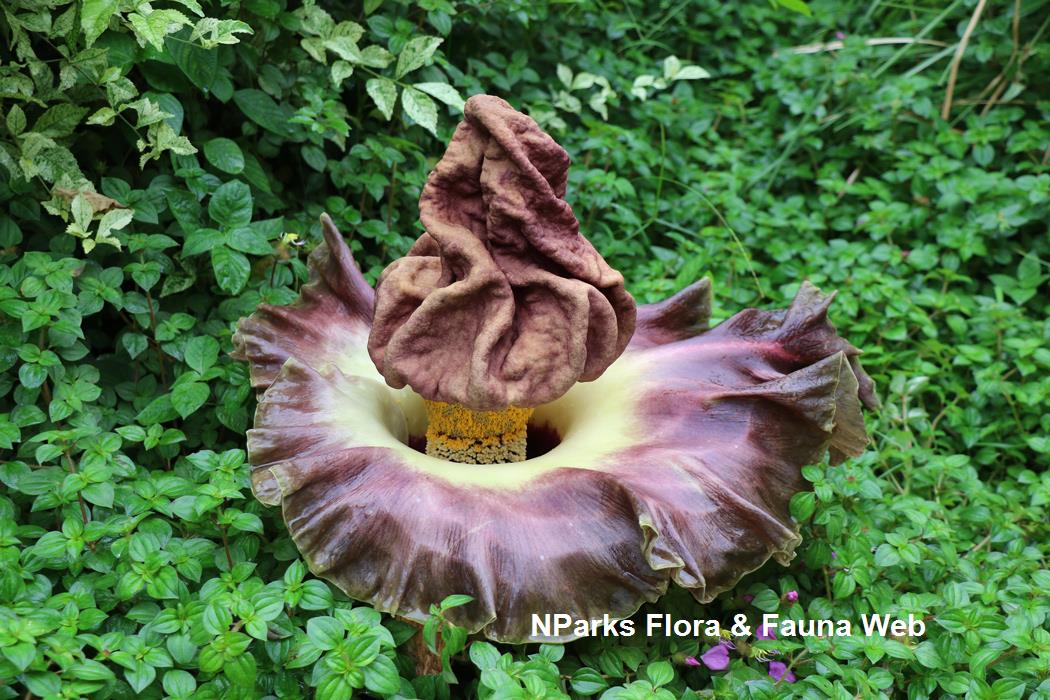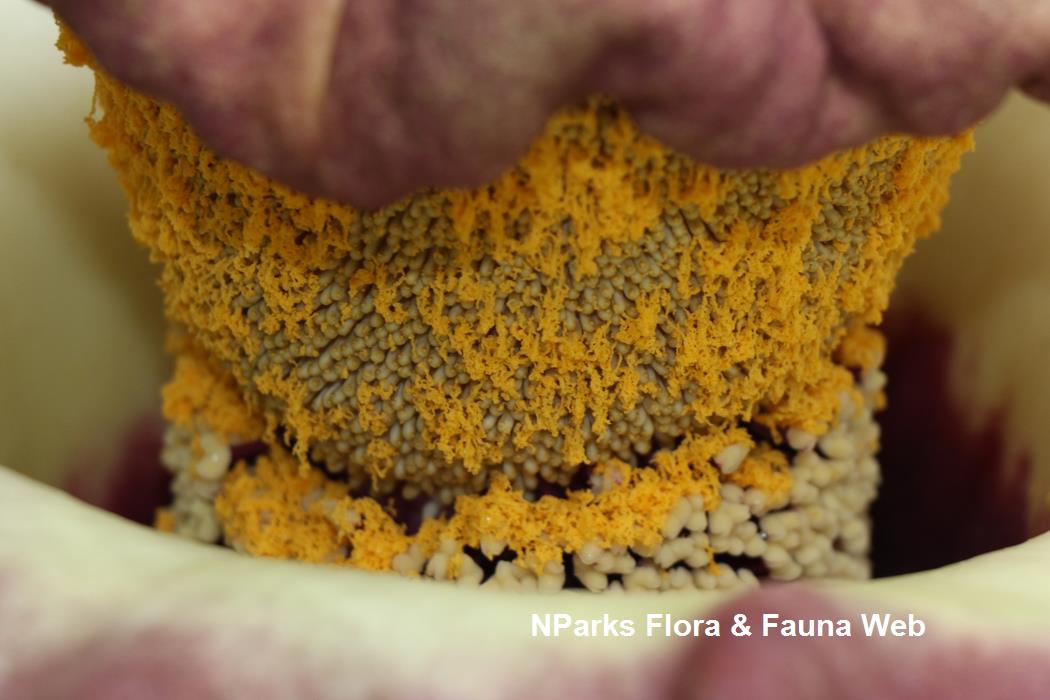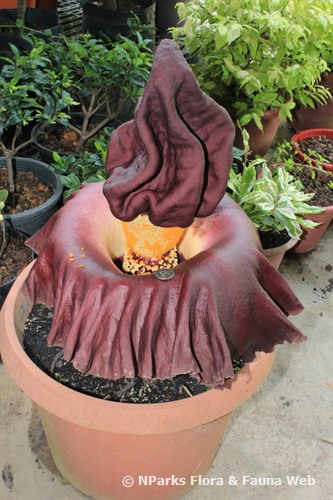
Back
Amorphophallus paeoniifolius (Dennst.) Nicolson
| Family Name: | Araceae |
| Synonyms: | Plesmonium nobile Schott., Amorphophallus giganteus Blume, Dracontium paeoniifolium Dennst., Arum campanulatum Roxb., Amorphophallus campanulatus Decne. |
| Common Name: | Elephant Foot Yam, Elephant Yam, Telinga Potato, Sweet Yam, Corpse Flower, Ubi Kekek, 巨花蒟蒻 |
The Elephant Foot Yam (Amorphophallus paeoniifolius) is a deciduous, herbaceous aroid. It can produce a single, umbrella-like leaf reaching 1m tall or a foul-smelling spadix and spathe from an underground stem called a corm. The edible corms are cut and thoroughly cooked in curries and stews in several Asian countries.
Name
Classifications and Characteristics
| Plant Division | Angiosperms (Flowering Seed Plants) (Monocotyledon) |
|---|---|
| Plant Growth Form | Herbaceous Plant |
| Lifespan (in Singapore) | Perennial |
| Mode of Nutrition | Autotrophic |
| Plant Shape | Umbrella |
| Maximum Height | 1.5 m to 2.5 m |
| Maximum Plant Spread / Crown Width | 3 m |
Biogeography
| Native Distribution | Assam, Bangladesh, East Himalaya, India, Sri Lanka, Andaman Island, China, Taiwan, Myanmar, Laos Vietnam, Cambodia, Thailand, Philippines, Malaysia, Sulawesi, Sumatra, Moluccas Island, New Guinea, Northern Australia |
|---|---|
| Native Habitat | Terrestrial (Disturbed Area / Open Ground, Secondary Rainforest) |
| Preferred Climate Zone | Tropical, Sub-Tropical / Monsoonal |
| Local Conservation Status | Non-native |
Description and Ethnobotany
| Growth Form | It is a deciduous, herbaceous aroid with a single leaf (rarely two) that grows up to 2.5m tall. The leaf is often mistaken for the entire plant, resembling a miniature tree. |
|---|---|
| Roots | The roots are borne at the top of the corm just below the leaf. The leaf and roots usually grow simultaneously; as the leaf dies down, the roots stop growing and eventually die as well. |
| Foliage | The leaf resembles a miniature tree, with a petiole (leaf stalk) reaching up to 1.5 m tall and 1.5 m across, with a highly dissected leaf blade. The petiole is often smooth, fleshy, green, and patterned with paler green spots or blotches. The cataphyll (a protective scale-like leaf that precedes the leaf shoot or subtends an inflorescence) is lanceolate and usually dull pink to purple and patterned in spots. The leaf eventually dies down and regrows from the corm during the following season. Several leaves may be produced from accessory corms at the base. |
| Stems | The stem is an underground corm (thick, often round, modified stem), reaching 40 cm in diameter and 25 kg in weight. The corm is dark brown, hemispherical, and covered in root scars. Offsets may be borne around the main corm. |
| Flowers | The inflorescence is a spadix borne on a short peduncle (central stalk on inflorescence) and subtended by a bell-shaped spathe. The spathe is dark brown to maroon with a yellow throat inside and pale green with white spots on the exterior, with glossy, wrinkled margins curving outward. The spadix can reach up to 25- 30 cm tall, with a bulbous appendix (upper, infertile portion of the spadix), followed by reduced male flowers and reduced female flowers towards the base. The inflorescence emits a foul, decaying odour, which fades after a few days. The inflorescence exhibits floral thermogenesis, generating heat over 2-3 days to disperse the odour, attracting potential pollinators such as carrion flies and beetles. |
| Fruit | The infrutescence is a cylindrical cluster of elongated berries that matures from green to bright red. |
| Habitat | It can be found in secondary forests, highly disturbed areas or on humus accumulated on rocks, in dappled shade of fully exposed ground at 0 - 700 m above sea level. |
| Associated Fauna | The flowers are pollinated by carrion flies and beetles. In its native range, the fruits are eaten by forest birds namely bulbuls (Pycnonotus spp.), koels (Eudynamys spp.), Oriental Magpie Robin (Copsychus saularis) and even birds-of-paradise (Paradisaea spp. - only in New Guinea). <3> Circular holes are occasionally observed on the leaflet edges, most likely created by leaf-cutter bees. |
| Cultivation | This species grows well in moist, well-drained, fertile soils with lots of organic matter, and areas of partial shade or full sun. Avoid planting in waterlogged clayey soils, which hinder corm formation and promote rotting. Corms are susceptible to soil nematodes. When dormant, avoid watering to replicate dry conditions to promote corm growth. It can be propagated by seeds, corms, and offsets. |
| Etymology | The genus Amorphophallus means 'misshapen phallus', an allusion to the shape of the inflorescence and corms (in some species). The specific epithet paeoniifolius means having leaves like Peony (Paeonia), which is named after ancient Greek physician Paeon, who was supposed to be the first to use plants medicinally. |
| Ethnobotanical Uses | Edible Plant Parts : Edible Storage Organs, Edible Leaves Food (Herb or Spice) (Fruit or Vegetable): The corms are edible, often found in Indian markets, and used in curries and stews in several Asian countries, especially Indonesia. The leaves and petioles are also cooked and eaten as a vegetable. (Note: All plant parts used for food should be thoroughly cooked to break down the calcium oxalate crystals, which would otherwise cause stinging and burning.) Medicinal: Dried corms are used medicinally to relieve piles, digestive problems and dysentery, while fresh roots are used as expectorant. People with rheumatism, arthritis, gout, kidney stones and hyperacidity should exercise caution when consuming the corms. |
Landscaping Features
| Landscaping | This species is suitable for parks and gardens that are partially shaded by tall trees or fully exposed to the sun. Plants will go dormant after their growing cycle, so they are best planted with a non-vigorous ground cover to hide the exposed soil. Alternatively, potted specimens can be planted into the ground during their growing cycle and removed when the plants go dormant. |
|---|---|
| Desirable Plant Features | Ornamental Flowers, Ornamental Foliage, Ornamental Form |
| Landscape Uses | Container Planting, Parks & Gardens, Focal Plant |
| Thematic Landscaping | Bird & Wildlife Garden, Economic Garden |
| Usage Hazard - Cons | Irritant - Sap, Toxic Upon Ingestion, Pungent Scent - Flowers |
| Usage Hazard - Cons Remarks | Irritant Sap/ Toxic Upon Ingestion: All plant parts contain calcium oxalate raphides, which are needle-shaped crystals that can cause irritation to skin, mouth and throat. Keep plants away from children and pets. Pungent Flowers: The inflorescence emit foul, decaying odour that resembles rotting flesh. The odour also attracts carrion flies, which may pose as a nuisance. |
Fauna, Pollination and Dispersal
| Fauna Pollination Dispersal Associated Fauna | Bird-Attracting (Fruits) |
|---|---|
| Pollination Method(s) | Biotic (Fauna) (Carrion Insects (Carrion Fly, Carrion Beetle)) |
| Seed or Spore Dispersal | Biotic (Fauna) (Birds) |
Plant Care and Propagation
| Light Preference | Full Sun, Semi-Shade |
|---|---|
| Water Preference | Moderate Water |
| Plant Growth Rate | Moderate to Slow |
| Rootzone Tolerance | Fertile Loamy Soils, Well-Drained Soils |
| Maintenance Requirements | Moderate |
| Pest(s) | Nematodes |
| Propagation Method | Seed, Storage Organ (Corm) |
| Propagation Method Remarks | Corms should be dusted with fungicide before being buried in the ground or a large, deep pot. After the leaf dies down completely, the corm can be harvested by carefully lifting it from the soil. Avoid injuring corms, which may result in rotting. |
Foliar
| Foliage Retention | Deciduous |
|---|---|
| Mature Foliage Colour(s) | Green |
| Mature Foliage Texture(s) | Glossy / Shiny, Raised / Sunken Veins |
| Foliar Modification | Flower/Fruit Bract |
| Foliar Type | Compound |
| Foliar Attachment to Stem | Petiolate |
| Foliar Venation | Pinnate / Net |
| Foliar Margin | Entire - Wavy / Undulate |
| Foliar Apex - Tip | Cuspidate |
| Typical Foliar Area | Mesophyll ( 45cm2 - 182.25 cm2 ) |
| Leaf Area Index (LAI) for Green Plot Ratio | 3.5 (Shrub & Groundcover - Monocot) |
Non - Foliar and Storage
| Stem Type & Modification | Acaulescent |
|---|---|
| Root Type | Underground (Fibrous Root) |
| Specialised Storage Organ(s) | Underground (Corm) |
Floral (Angiosperm)
| Flower & Plant Sexuality | Unisexual Flowers , Monoecious |
| Flower Colour(s) | Brown, Cream / Off-White, Red |
|---|
| Flower Grouping | Cluster / Inflorescence |
| Flower Location | Terminal |
| Inflorescence Type | Spathe & Spadix |
| Ovary Position | Superior / Hypogynous |
| Flowering Period | Rarely |
| Flower Lifespan on Plant | 2-3 Days |
| Flower Lifespan on Plant - Remarks | Female flowers mature on the first day and the male flowers mature in the second and sometimes into the third day |
| Flowering Habit | Polycarpic |
Fruit, Seed and Spore
| Mature Fruit Colour(s) | Red |
|---|---|
| Fruit Classification | Simple Fruit |
| Fruit Type | Fleshy Fruit , Berry |
| Mature Seed Colour(s) | Brown |
| Seed Quantity Per Fruit | Few (1-5) |
References
| References | <1> eMonocot Team Amorphophallus paeoniifolius - (Dennst.) Nicolson CATE Araceae https://cate-araceae.myspecies.info/taxonomy/term/7782/descriptions (accessed 4 April 2025) <2> Jansen, P.C.M., van der Wilk, C. & Hetterscheid, W.L.A., 1996. Amorphophallus Blume ex DecaisneIn: Flach, M. & Rumawas, F. (Editors). Plant Resources of South-East Asia No. 9: Plants yielding non-seed carbohydrates. Backhuys Publisher, Leiden, The Netherlands, pp. 45-50. <3> Low, S.L. (2024). Avian frugivory and seed dispersal in Amorphophallus paeoniifolius and Alocasia odora. Trop Ecol.65, 321–329.
|
|---|
Image Repository
Others
| Master ID | 363 |
|---|---|
| Species ID | 1659 |
| Flora Disclaimer | The information in this website has been compiled from reliable sources, such as reference works on medicinal plants. It is not a substitute for medical advice or treatment and NParks does not purport to provide any medical advice. Readers should always consult his/her physician before using or consuming a plant for medicinal purposes. |






























.jpg)